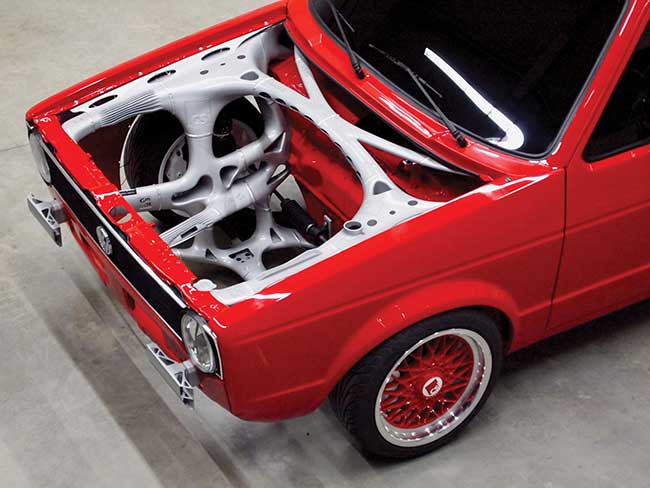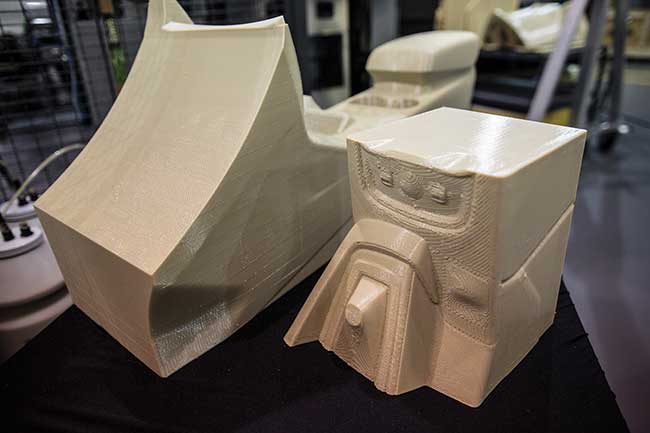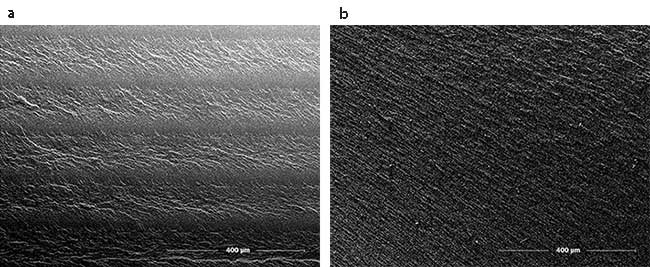Additive manufacturing builds up parts by binding plastics and other materials together, with lasers, LEDs, other light sources, heaters or electron beams supplying the necessary energy. The resulting parts are light yet still strong. What’s more, they can be built to order and customized as needed.
Additive manufacturing, aka 3D printing, makes parts one at a time and eliminates the need for retooling when a design is changed. It is used for aerospace, military and other demanding applications, as well as in automotive prototyping or other areas where it offers a cost advantage. For now, high-volume additive manufacturing remains more expensive than traditional production, but the goal is to make it part of the standard manufacturing tool kit.

A 3D-printed front-end structure built by EOS in collaboration with Altair, APWORKS and csi. Courtesy of EOS.
At its Michigan headquarters, the Ford Motor Company uses additive manufacturing to cut the cost of developing new cars, a process that involves several prototype cycles.
“Early phases are as much additive as we can possibly use, so we can avoid prototype tooling costs because prototype tools are expense money,” said Harold Sears, technical leader for 3D printing and additive manufacturing technologies.
Prototype tools are not capital investments and often only make a few parts. “It’s really a shame to have to pay for a $100,000 tool and make 20 parts off of it and throw it away,” Sears said.
He added that the cost of a 3D-printed part ranges from $20 to $2000, depending on the complexity and size of the part. So, the savings can be considerable in prototyping. Sears estimated that the company makes over 100,000 parts a year using additive manufacturing.
In Ford’s current vehicle development approach, additive manufacturing use fades away as cars move closer to volume production and the cost advantage swings from 3D printing to traditional manufacturing. During the changeover, materials may switch to those more suited to the demanding automotive environment, where temperature swings can be large with heat, oil and dust thrown in. The change is partially necessary because a good material for 3D printing may not be suitable for the application or the traditional manufacturing methods used in high-volume production.
Eventually, the plan is to use additive manufacturing to make vehicle parts, as this offers greater personalization of cars. In addition, 3D printing allows greater optimization of part shapes than is possible with traditional manufacturing. With it, you can create parts that are lighter or have other important improvements such as better heat transfer or energy absorption, which could be beneficial in protecting passengers during a crash.
The transiton requires rethinking how parts are designed, something that Ford is working on, said Ellen Lee, technical leader for additive manufacturing research. A changeover from traditional manufacturing is not something that can be done partially for a given part, she added. But it can be piecemeal in terms of the different parts that make up a car, with components transitioning from old to new approaches when it makes sense.
In addition, 3D printing could make traditional methods more efficient by allowing customization of tooling to fit people of different height, reach and hand size. Taking advantage of any of these opportunities in a mass production line will require advances in additive manufacturing systems that boost throughput and cut costs, which may mean changes are required in the photonics that power such systems.
“Really having stronger light sources or cheaper light sources so you can have many of them, like arrays of them, will help improve throughput, the size as well as the speed of some of these processes,” Lee said.
In March 2017, Ford announced it was testing large-scale 3D printing. Lightweighting and customer personalization were the two reasons given. “Increasingly affordable and efficient, 3D-printing large automotive parts, like spoilers, could benefit Ford’s business and its customers,” the company said in a release. “Printed parts can be lighter in weight than traditionally manufactured parts, and may help improve fuel efficiency.”

Ford Motor Company is testing 3D printing of large-scale car parts using the Stratasys Infinite Build 3D printer. Courtesy of Ford.
In response to market demands from automakers and other customers, producers of additive manufacturing systems are working to cut costs, improve capabilities, increase part performance and more. They are doing so in different ways.
HP Inc., for example, is building systems based on multi-jet fusion technology. It uses an approach similar to that in 2D inkjet printers, with one difference being that the printing is done on a plastic powder bed and not paper.
“We take this PageWide array, and we traverse that across a powder bed,” said David Tucker, market development manager for 3D printing. “As it’s going across the powder bed, it deposits that crystal-clear image you’d see on your 2D print, but just on plastic powder instead.”
The system uses two light bars. One heats up the material before deposition of the photoreactive agents, and the other fuses the agents into the powder through the application of infrared light. Every layer takes seven seconds to create, Tucker said, and the strength of the resulting part is the same in X and Y, with the Z direction slightly weaker. HP says that the resulting 3D printing is up to 10× faster at half the cost as compared to the alternative, selective laser sintering.
Selecting the right material
The photonics-related items that make this process work are the light sources, the photoreactive agents, and the cameras or vision systems that are used for process control and part inspection. The agents must bind to the plastic being used and react to the light source, which means that the best agent for a specific application may not be the best for another.
In automotive applications, for instance, parts may be exposed to the sun and its ultraviolet rays for years. The material used must be UV resistant as well as able to take vibration and wide temperature swings. The same mix of attributes will not be needed for a part destined for an office application.
HP hopes to find solutions that will drive down material prices by providing an open platform, Tucker said. Thus, the HP system could be customized through software and materials, much like a phone is with apps or a computer with programs. Tucker added that the company is close to being able to produce systems that can tailor part properties on a voxel-by-voxel basis. The capability to alter characteristics in this way means that adjustments could be made to such basic properties as the elastic modulus, which would give designers another knob to tweak when creating a part.
Additive manufacturing solves some problems presented by subtractive methods that require skilled personnel, take time and impose constraints on the finished parts, said Jon Walker. He is key account manager for automotive for EOS North America, a subsidiary of the selective laser sintering system maker EOS GmbH of Krailling, Germany.
One of the ways in which the cost of additive produced parts can be cut, he said, is by monitoring the production process. This can range from a simple webcam to a three-dimensional image capture system, with the data used to determine that there are no voids, inclusions or other defects that will degrade the performance of the finished part. A 3D-vision scanning system is used, for instance, to inspect patient-specific surgical guides that are custom made via 3D printing.
“The big benefit is to minimize surgical errors, and it also helps to minimize scarring as well because you make one precision cut,” Walker said.
Looking forward, Walker noted that plastic 3D printers from EOS — like its newly released EOS P 500 — can now run full-scale production on a large build platform. He added that true production manufacturing, not rapid prototyping, is where the industry is headed and systems will be designed around this concept.
The company’s plastics machines currently use only CO2 lasers for a light source, while its metal additive manufacturing machines use fiber. Eventually, Walker believes fiber lasers are likely to be used for its plastic 3D printers as well.
Layerless parts
A different approach is being taken by Carbon Inc. of Redwood, Calif. The company’s products use DLP (digital light projection) to image a cross section of the part into light-sensitive liquid resin. The light, which is from an LED emitting at 385 nm, polymerizes the resin to lock in the geometry of the part, with a subsequent baking step activating secondary chemistry that enhances mechanical properties.

A comparison of the traditional layer-by-layer 3D printing approach (a) to one that images a cross section of the part into light-sensitive liquid resin (b), a layerless approach that results in equal mechanical properties in all directions. Courtesy of Carbon Inc.
This method offers benefits, said Kirk Phelps, vice president of product management. He said the technology enables very fast printing — up to 100× faster than competitive technologies that are based on lasers. The result, Phelps said, is “completely isotropic, layerless parts that combine high resolution with production-grade mechanical properties. Designing our M2 printer around high-intensity DLP projection technology instead of a beam-steered laser allowed us to maximize these advantages for a wide range of different part geometries.”
He added that multiple materials can be incorporated, so that parts can be composed of more than one polymer. The company is conducting some preliminary research and development work so that parts can include glass and metal filler particles, which would expand the applications the parts could satisfy. The company is in partnership with automakers Ford and BMW as well as Tier 1 parts supplier Delphi to produce vehicle parts. It also is working with shoemaker Adidas, with the goal being to 3D print as many as 100,000 shoe soles by the end of 2018.
The widespread adoption of 3D printing and additive manufacturing could have a profound impact on manufacturing and the supply chain, said HP’s Tucker. Many companies once made parts in-house or nearby. Today, manufacturing is concentrated in large mega-facilities full of equipment dedicated to individual tasks, with long supply chains as a result. Because additive manufacturing does not require dedicated machines for each part and enables small-batch production, it may be possible for companies to make their own parts again. The switch could eliminate wait times and shipping costs and open the way for yet another change in the way manufacturing is done.
When that time comes, mused Tucker, manufacturers will have to ask themselves some critical questions: “Is it still in our best interest to manufacture things the way we’re making them today? Or do we look at a decentralized approach?”